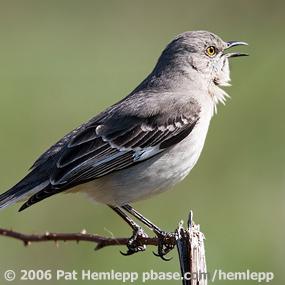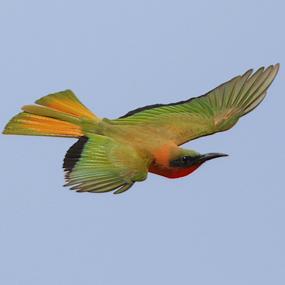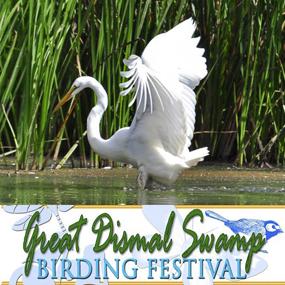For “Winged Wednesday”:
Golden-cheeked Warbler
.jpg)

“If you’re lucky, you might spot the Golden-cheeked Warbler on its breeding grounds in central Texas at this time of year. The snazzy-looking adult male is particularly striking, with a golden-yellow eyebrow and cheek-patch, split by a black eye-stripe that joins its black nape and back.
The Golden-cheeked Warbler depends on the bark of the Ashe juniper for nesting material and tends to forage in deciduous oaks. Its ideal habitat consists of mixed juniper-oak woodlands.
Major threats are habitat fragmentation and degradation caused by ranches and housing developments, the effects of global climate change, lack of prescribe d fire, which clears the forest understory to provide habitat, and removal of Ashe juniper trees. Habitat fragmentation compounds the impact of additional threats such as cowbird parasitism, overbrowsing by deer, and the spread of oak wilt fungus.
d fire, which clears the forest understory to provide habitat, and removal of Ashe juniper trees. Habitat fragmentation compounds the impact of additional threats such as cowbird parasitism, overbrowsing by deer, and the spread of oak wilt fungus.
ABC is determined to ensure the species’ survival at both ends of its range. The ABC-led Oaks and Prairies Joint Venture is coordinating with partners to enhance habitat management programs on the Golden-cheeked’s breeding grounds. ABC’s Quercus and Aves Program has worked to conserve and expand threatened oak woodland in its wintering range, and ABC’s Migratory Bird Program has begun a habitat protection program at the El Jaguar Reserve in Nicaragua that could benefit this attractive species.”
Support ABC's efforts to conserve native birds and their habitats! Photo by Greg Lavaty; Range Map by NatureServe
__________
God, Science & the Bible: Hummingbirds - How Do They Do That?
“The incredible aerial feats of hummingbirds are truly a marvel. But that's only the beginning of the story.
"Oh look, there's one!" shouts a small boy. Suddenly a ruby-throated hummingbird darts up to the apple-red nectar feeder on the deck, flits about, and then, hovering in mid-air, inserts his beak and tongue into the opening and extracts the high-energy sugar water needed to fuel its incredible flying acrobatics. A little later another hummingbird, to impress an admiring female, zooms straight up 130 feet and then swoops to the ground, creating a loud shrill burst of noise produced through its tail feathers.
"Wow, how do they do that?!" exclaim those on the deck watching such feats of fancy flight in wonder. Many feel blessed to witness such wonders of nature and give glory to God as Creator and Master Designer. And rightly so.
"Not so fast," counter most educators and naturalists. Even as they gush about the "unique architecture" of hummingbirds, they deny any Master Architect. They claim these living, breathing miniature helicopters somehow evolved over eons of time without the involvement of an Intelligent Designer. Imagine making such a claim about a Black Hawk helicopter with its aeronautical and technological features! Yet when do hummingbirds crash? Or need a pilot?
Now, thanks to high-speed photography, which can be viewed in slow motion, we can see the amazing specially created features of this miracle bird!” http://dsc.discovery.com/tv-shows/other-shows/videos/time-warp-hummingbird-in-high-speed.htm More at: http://www.ucg.org/science/god-science-bible-hummingbirds-how-do-they-do/ article by Robert Curry
_______
Rebuilding bayside beaches crucial to some birds' survival
Truckloads of sand are dumped and spread along the shore at Kimbles Beach, along the Delaware Bay in Middle Township. This is being done to restore vital horseshoe crab breeding habitat that was destroyed during Superstorm Sandy. / Associated Press
MIDDLE TWP. — “On both sides of New Jersey, dump trucks are depositing sand and bulldozers are racing against time to spread it out.
Along the ocean, the goal is to restore beaches destroyed by Superstorm Sandy before the tourists arrive. But along Delaware Bay, the beaches need to be ready before the endangered shore birds arrive. A potential environmental crisis looms that could further deplete the number of already endangered shore birds that depend on beaches along the state’s western coast as a stopover in their South America-to-Arctic migration.
The October storm that caused so much devastation along the ocean also pounded the bay’s coast, flooding homes and washing away beaches. It is those lost beaches that could spell disaster for species such as the red knot, a bird already on New Jersey’s endangered species list and one that’s been proposed for inclusion on the federal list.
Red knots and other shore birds land on Delaware Bay beaches by the hundreds of thousands each May, gorging themselves on horseshoe crab eggs to fatten up for the second half of their arduous 10,000-mile migration to Canada. But Sandy washed away about 70 percent of the beaches where horseshoe crabs lay their eggs and where the birds pig out each spring.” More at: http://www.courierpostonline.com/viewart/20130408/NEWS01/304080019/Rebuilding-bayside-beaches-crucial-some-birds-survival
______
Adorable Baby Owl Makes Zoo Debut
 “A four-week-old female Eurasian eagle-owlet made its public debut at the National Aviary zoo on Monday in Pittsburgh.
“A four-week-old female Eurasian eagle-owlet made its public debut at the National Aviary zoo on Monday in Pittsburgh.
The owlet hatched on March 13 and, according to zoo officials, just over 50 of these birds are located in accredited zoos in the United States.
The largest of the owl species, Eurasian eagle-owls are found in North Africa, Europe, Asia and the Middle East and can grow up to two and a half feet with a wing span of nearly five feet. According to the zoo, very often the owls mate for life and tend to nest on sheltered cliff ledges, crevices between rocks and cave entrances.” More at: http://www.weather.com/travel/baby-owl-born-photos-20130409
______
Once-emaciated owl set free in farm field
 “The baby white owl was released under the watchful eye of his caregivers at the Mountainaire Avian Rescue Society (MARS) in a farm field off Comox Avenue.
“The baby white owl was released under the watchful eye of his caregivers at the Mountainaire Avian Rescue Society (MARS) in a farm field off Comox Avenue.
“He was sighted by a person who came to view swans in the Comox Bay ... and noticed the little owl was hiding beneath a tree covered in mud and feces from the swans,” said Reg Westcott of MARS. “(The owl) got contaminated with some mud and could no longer fly or bathe himself. He was essentially so skinny that he needed rescue so maybe the best thing that could have happened to him is that he got covered in mud in a place where people could see him.
Westcott said he suspects the owl was born last year in the Arctic. It required care every hour, for 24 hours a day to nurse the emaciated bird back to health.” More at: http://www.northislandmidweek.com/news/201131981.html
______
Migrating and Breeding Birds Need Your Help
Ten Ways You Can Protect Birds This Spring

Ruby-throated Hummingbird by Bob Johns.
(Washington, D.C., April 10, 2013) “As temperatures start to climb, birds begin their annual spring migration and also begin breeding. American Bird Conservancy (ABC) often gets asked, particularly during the spring, “How can I help the birds?”
Here are the top ten things ABC recommends people do to aid or protect birds in their homes and yards.” Read here: http://www.abcbirds.org/newsandreports/stories/130410.html
______
First bees, now birds seen dying from EPA-approved pesticides
![images[11] images[11]](https://blogger.googleusercontent.com/img/b/R29vZ2xl/AVvXsEh2gcwLf722ImpwZwPdEsmgZd38cQlvLqzriDVfoutyVU8FhuyxRNHWz_oere7JgtOKM4-pfn7trTGJkeKy8GW0t30_PH0zs6ofBI_4p9IkSzC2eINT0p0YSSV6ZDvd_s1GUclA02sre7zl/?imgmax=800)
"These products are much more dangerous than we expected to birds and wildlife," said the American Bird Conservancy's Cynthia Palmer of the insecticides known as "neonicotinoids," which commercial beekeepers blame for killing off thousands of hives.” More at: http://washingtonexaminer.com/first-bees-now-birds-dying-from-epa-okd-pesticides/article/2526045
______
Leading Bird Group Wants New DOI Secretary to Review Possible Revised Rule Weakening Eagle Protections for Wind Industry

______
Upcoming Shows
Mockingbirds, Bee-eaters, and Sandpipers ...
 Northern Mockingbird
Northern Mockingbird
SUNDAY Northern Mockingbird by Ellen Blackstone LISTEN NOW ►
 Red-throated Bee-eater
Red-throated Bee-eater
MONDAY A Rainbow of Bee-eaters— Birding in Ghana by Chris Peterson LISTEN NOW ►
TUESDAY Chicago Volunteers Rescue Birds featuring Annette Prince and volunteers of CBCM LISTEN NOW ►
 WEDNESDAY Great Dismal Swamp Birding Festival April 25-27 by Todd Peterson LISTEN NOW ►
WEDNESDAY Great Dismal Swamp Birding Festival April 25-27 by Todd Peterson LISTEN NOW ►
THURSDAY High Island - Migration on the Gulf by Bob Sundstrom LISTEN NOW ►
FRIDAY The Lost Bird Project - Sculptor Todd McGrain Documentary airs on PBS on or near Earth Day 2013 by Chris Peterson LISTEN NOW ►
SATURDAY Probing with Sandpipers by Bob Sundstrom LISTEN NOW ►
_______
On This Day:
A single horsehair uncovers a murderer, Apr 17, 1936:
“After a week of tracking down every conceivable lead, police finally find the evidence they need in order to break the case of Nancy Titterton's rape-murder in New York City. Titterton, a novelist and the wife of NBC executive Lewis Titterton, was raped and strangled in her upscale home on Beekman Place on the morning of April 10, 1936. The only clues left behind were a foot-long piece of cord that had been used to tie Titterton's hands and a single horsehair found on her bedspread.
These small traces of evidence proved to be enough to find the killer. The detective in charge of the investigation had ordered his team to trace the source of the cord. After a full week of combing every rope and twine manufacturer in the Northeast, the cord was finally found to have come from Hanover Cordage Company in York, Pennsylvania. Company records showed that some of the distinctive cord had been sold to Theodore Kruger's upholstery shop in New York City.
Since the investigation of the horsehair had already led police to suspect John Fiorenza, an assistant at Kruger's shop, this new evidence only solidified their suspicion. Fiorenza and Kruger were the first to discover Titterton's body, when they arrived to return a repaired couch (which had been stuffed with horsehair that matched the one found at the crime scene) on the afternoon of April 10. However, they both denied entering the bedroom that day.
When investigators learned that Fiorenza had been at the Titterton house on April 9 and had been late for work the morning of the murder, they looked deeper into his background. Fiorenza had four prior arrests for theft and had been diagnosed as delusional by a prison psychiatrist. Detectives first gained Fiorenza's trust by pretending to need his help in solving the crime and then sprang the cord evidence on him.
Caught by surprise, Fiorenza confessed to the brutal crime but claimed that he was temporarily insane. This defense didn't hold up too well at trial, and Fiorenza was executed on January 22, 1937.”
From me: Killers weren’t kept on death row for ages back then.
_______
Apollo 13 returns to Earth, Apr 17, 1970:
“With the world anxiously watching, Apollo 13, a U.S. lunar spacecraft that suffered a severe malfunction on its journey to the moon, safely returns to Earth.
On April 11, the third manned lunar landing mission was launched from Cape Canaveral, Florida, carrying astronauts James A. Lovell, John L. Swigert, and Fred W. Haise. The mission was headed for a landing on the Fra Mauro highlands of the moon. However, two days into the mission, disaster struck 200,000 miles from Earth when oxygen tank No. 2 blew up in the spacecraft. Swigert reported to mission control on Earth, "Houston, we've had a problem here," and it was discovered that the normal supply of oxygen, electricity, light, and water had been disrupted. The landing mission was aborted, and the astronauts and controllers on Earth scrambled to come up with emergency procedures. The crippled spacecraft continued to the moon, circled it, and began a long, cold journey back to Earth.
The astronauts and mission control were faced with enormous logistical problems in stabilizing the spacecraft and its air supply, as well as providing enough energy to the damaged fuel cells to allow successful reentry into Earth's atmosphere. Navigation was another problem, and Apollo 13's course was repeatedly corrected with dramatic and untested maneuvers. On April 17, tragedy turned to triumph as the Apollo 13 astronauts touched down safely in the Pacific Ocean.”
_________
Yesterday:
After I had given Mikey his pills, and bought some gas for the Puddle Jumper and the lawnmower, Misty and I had our walk down at Jay’s. We had something to take to his mother. Jay wanted to come here and weed-whack, as I don’t have one yet. So that is what he did. I started the burn pile, and had to keep on attending to it. The smoke seemed to follow us, wherever we went.
Jay put some gas in my mower, but it started doing the same thing it did last year and leaked gas out of the carburetor. So I took it to Jim the mechanic when I took Jay home. Jim said that the float was sticking, and fixed it. He said that if it does it again, it will need a new carburetor. Mine is a mulching mower, and that is why I like it. Jim has a very nice big wheel mower that I could buy, but it won’t fit in my present lawnmower shed. When we get a larger lawnmower shed built on Lot 1, I’ll probably get it.
Ray wanted to work in the afternoon, so we vacuumed all the carpet and sprayed it with a disinfectant which also has a virucide in it. Especially under my dining table, as that was one of Terry’s favorite places. We are trying to make sure we kill all germs from Terry-cat before I bring another cat here. I washed all of Misty’s blankies and beds, and bathed her too. Her hair is getting long, so it took both of us to brush-dry her.
We placed the two used air conditioners on a table in front of the garage door, which makes a good backdrop for taking pictures, so I can get them advertised. Then moved them back into the garage for safekeeping. Good thing I am strong, as the big heat/air one is heavy.
So it was another busy day.




















No comments:
Post a Comment